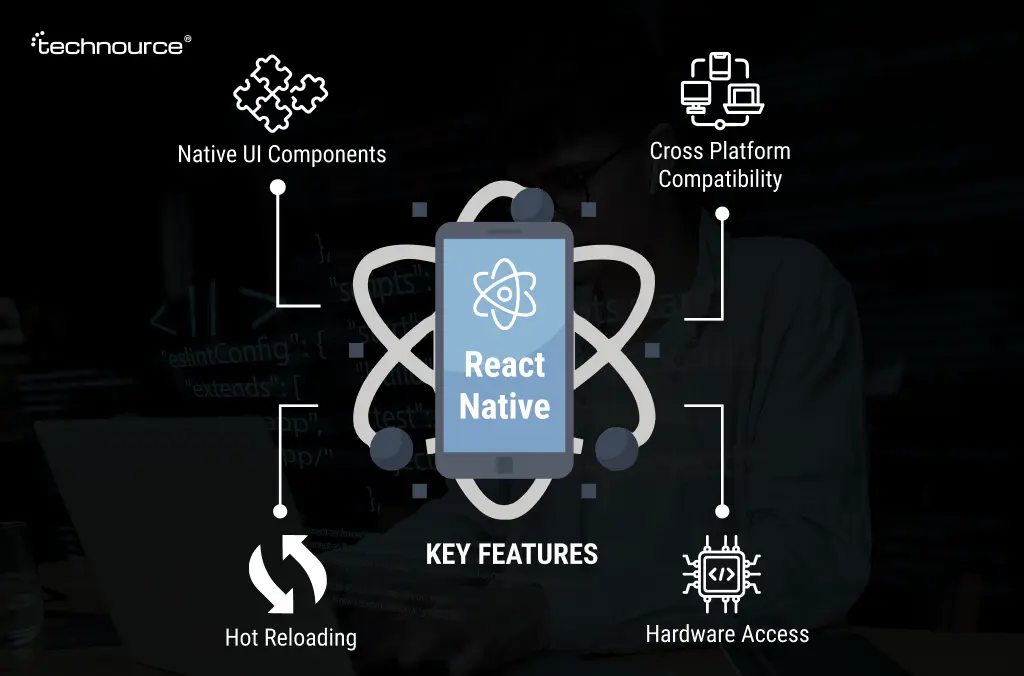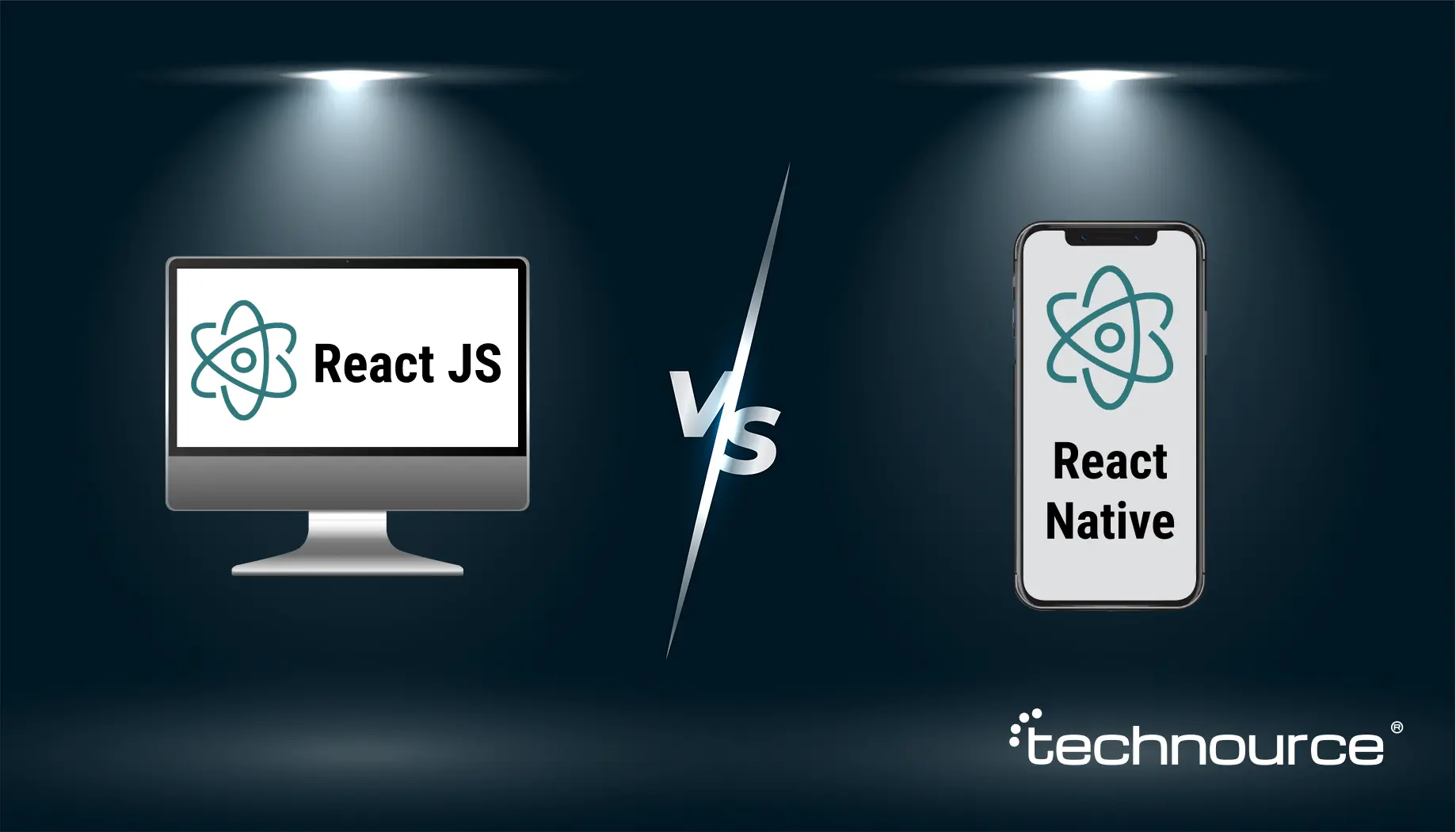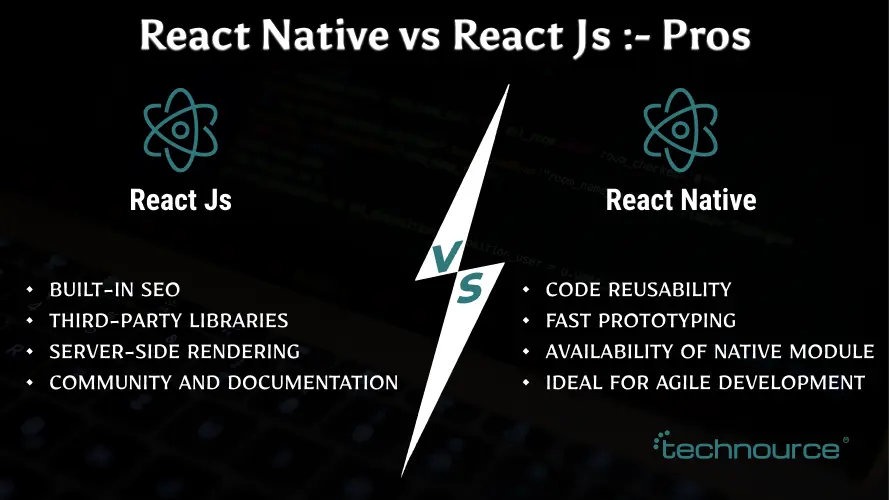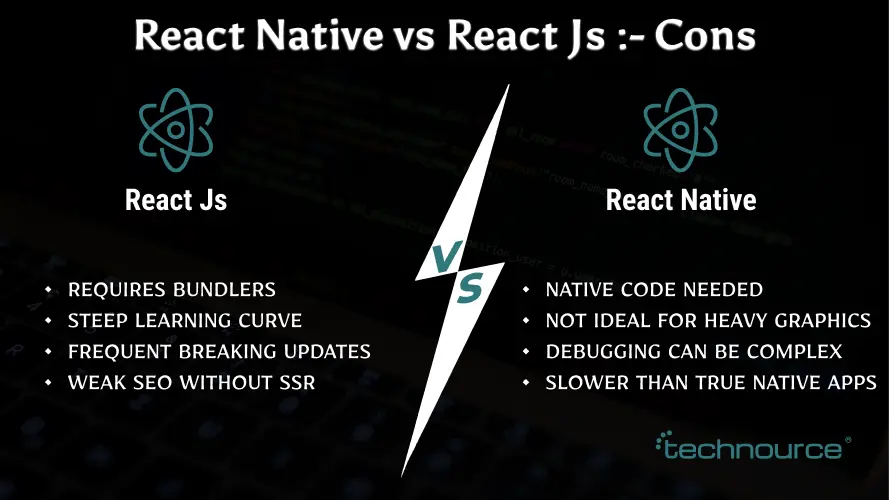React vs React Native: Choosing the Right Tool for Your Next App
Quick Recap: If you’re stuck in choosing between React and React Native, this exclusive guide is written just for you. React is perfect for creating high-performance, dynamic web UIs, while React Native is best when you need to create mobile apps that work on both Android and iOS. This blog covers in-depth comparison of React vs React Native along with main differences, applications, advantages and disadvantages, and assists you in selecting the most suitable technology for your future project.
Choosing the right technology for your app isn’t just a technical decision, it’s a strategic one that will affect every corner for your business. If you’re building a digital product, we are predicting that you’ve surely heard about React and React Native. Though they sound similar, they serve for very different purposes.
React enables dynamic web interfaces, while React Native is all about building a mobile app that feels and behaves like a native app. Both are from Meta’s stablew quickly you want to get
What is React?
React, or ReactJS, or React.js, is an open-source JavaScript library developed and supported by Facebook. It is most commonly used for constructing swift, dynamic, and interactive web user interfaces. React pioneered a revolutionary way of UI development for businesses.
But choosing React over React Native, or vice versa, is not always easy. This exclusive guide takes you through their fundamental differences, applications, advantages, disadvantages, and how to pick the right one based on your project requirements.
So, without further ado, let’s begin.
It supports development with its component-based system, which enables developers to create complex interfaces by combining reusable components, such as Lego blocks.
Prior to React, programmers used to use conventional DOM manipulation methods which were tedious and less productive, particularly for big applications. React revolutionized how applications were built by bringing in the Virtual DOM, which reduces direct modification of the real DOM, leading to significantly better performance and responsiveness.
The declarative nature of React’s syntax allows UIs to be easily comprehensible and manageable. Rather than specifying the process of updating the UI, you specify what the UI should appear like in any given state, and React takes care of the rest. This reduces bugs as well as improves productivity among developers.
React is also framework-agnostic and collaborates nicely with different tools and stacks. It gets along very well with Next.js for server-side rendering and static site generation, and it also gets along well with state management libraries such as Redux and Recoil.
Its flexibility makes it perfect for anything from admin dashboards and landing pages to full-fledged web applications that serve millions. React is the backend for tech giants such as Dropbox, Facebook, Airbnb, and WhatsApp Web, which says it all about its scalability and stability.
Consequently, companies opting for ReactJS development services enjoy a rich ecosystem, a large talent pool of developers, and ongoing patches from Meta. Whether you’re creating a new SaaS application or overhauling your e-commerce website, React gives you the blocks to develop an interesting user experience.
In order to find professional solutions or scale up your web development company rapidly, you can hire ReactJS developers of the highest quality to customize your project.
Key Features of React
- Virtual DOM: Improves performance by updating only parts of the web page that change
- Component-based architecture: Breaks UI into small, reusable components
- One-way data binding: Provides better control over the flow of data
- Strong ecosystem: Supported by powerful libraries like Redux, Next.js, and React Router
Popular Use Cases
- Dashboards and analytics platforms
- SaaS products
- Web portals for banks, e-commerce, or healthcare
Real Example
React helps big brands like Netflix to ensure they can deliver high dynamic user experiences on devices, such as smart LED TVs. React empowers Netflix to provide quick load times and seamless UI transitions.
What is React Native?
When we discuss React Native the first and foremost thing that we must know about this JavaScript framework is that it is designed specifically for building high-performing mobile and cross-platform applications.
The major USP of React Native lies in enabling developers to write code once and use it on both iOS and Android platforms, directly reducing development time and cost without sacrificing quality.
Founded by Facebook in 2015, React Native was developed to fill the gap between the performance of traditional native applications and the development efficiency of web technologies. It allows teams to build apps that look and feel real native, using familiar JavaScript and React models.
Working as a blessing for businesses and startups who are looking to get their product to market quickly, React Native offers an extra competitive edge. With a large pool of talent available in this technology, it’s now easier than ever to hire React Native developers who can build feature-rich mobile apps using this technology.
Another top advantage of React Native is it’s ability to access platform APIs through native modules. This means your application isn’t limited by the framework; you can incorporate custom features written in Java (for Android) and Swift/Objective-C (for iOS) whenever required. React Native also have benefits from tools like Expo, which streamline development and testing as the development progresses.
Its immense popularity hit the minds of tech giants like Uber Eats, Discord, Bloomberg, and Tesla, which use it to speed up their mobile app development and unify app experiences across devices.
React Native has also proven its worth for companies working on a fixed or tight budget, also those who are under quick launch timelines.
Whether you’re a startup building an MVP or an enterprise scaling mobile platforms, React Native app development services remain a top choice for efficient, scalable app development.
Key Features of React Native
- Cross-platform compatibility: Single Codebase for android and IOS.
- Native UI components: Provides smooth user experience rendering Components platform specific.
- Hot Reloading: It allows developers to instantly see code changes without rebuilding apps which boost speed of development.
- Hardware Access: It allows integration to hardware devices (camera, GPS, etc.) for a good user experience.
Popular Use Cases
- Cross-platform apps for startups and SMBs
- MVPs for faster time-to-market
- Apps that don’t require heavy animations or platform-specific designs
Real Example
Instagram migrated key parts of its app to React Native, allowing the team to maintain a unified codebase for both platforms.
Difference Between React and React Native
Here’s a side-by-side comparison of React and React Native to help you better understand their distinct purposes:
| Feature | React | React Native |
|---|---|---|
| Target Platform | Web Browsers | IOS and Android Mobile Apps |
| Rendering | Uses HTML and CSS | Uses native UI components |
| Navigation | React Router | React Navigation |
| Styling | CSS or styled-components | StyleSheet object (custom CSS-in-JS) |
| Code Sharing | Web-specific code | Shared codebase across platforms |
| Performance | High performance for web applications | Near-native performance for mobile apps |
| Third-party Libraries | Extensive, wide community support | Requires additional bridging for native libraries |
Use Cases of React and React Native
React JS
React is ideal when you’re building:
- Content-heavy websites (news portals, blogs)
- Real-time dashboards (e.g., sales analytics)
- E-commerce platforms with filters, cart and payment systems
Case Study: Airbnb Web
Airbnb uses React to maintain highly interactive search and booking interfaces. With reusable components, they ensured consistent UI and performance optimization.
React Native
React Native excels in scenarios like:
- Apps with a shared codebase for Android and iOS
- MVP development for early-stage products
- Startups that want to launch faster without managing two native codebases
Case Study: Tesla Mobile App
Tesla’s mobile application leverages React Native for managing car functions, charging, and updates across both platforms.
Pros and Cons: React Native vs React
React Pros
- Built-in SEO capabilities
- A large number of third-party libraries
- Server-side rendering via Next.js
- Mature community and documentation
React Native Pros
- Reuse up to 90% of the code
- Fast prototyping
- Native modules available for core device features
- Ideal for agile mobile development
React Cons
- Requires bundlers like Webpack
- Steeper learning curve with modern tools
- Chances of Code breaking due to Frequent updates
- SEO can be poor without SSR(Server-side rendering)
React Native Cons
- Native modules may require platform-specific code
- Performance is good, but not ideal for gaming or 3D rendering
- Multiple layers can cause debugging React native apps more challenging
- It gives slightly slow performance as compared to other fully native applications
Explore top ReactJS tools in our exclusive guide to ReactJS Developer Tools.
React Native vs React JS: Which One to Choose?
Choosing between React or React Native depends on several factors:
- Platform Goals:
- If it’s only a web application development, go for React.
- If you’re targeting both iOS and Android, React Native saves time and cost.
- Developer Skills:
- React is a prerequisite to mastering React Native. Start there.
- Performance Needs:
- For complex, animated UIs, go native. React Native handles simple UIs well.
- Time to Market:
- React Native is faster when you need mobile apps quickly.
- Budget Constraints:
- A shared codebase reduces development costs significantly.
Expert Opinion:
Start with React for the web. If your business expands into mobile, reuse your React knowledge in React Native.
Conclusion
Both React and React Native are powerful tools backed by Meta, and they offer incredible value depending on your needs. Here’s the essence:
- React JS is the go-to for modern, scalable, and SEO-friendly web applications.
- React Native makes it easier to deploy mobile apps on platforms quickly and affordably.
Still not sure where to go? That’s where we step in.
At Technource, our technical development team has assisted in the launch of MVPs for startups within weeks through React Native and helped enterprise customers scale sophisticated web platforms with ReactJS. Our team applies extensive technical expertise, agile practices, and problem-solving skills to each engagement.
Regardless of whether you want to get ReactJS developers to scale your web platform or want to hire React Native developers to develop your mobile application, we have you covered.
We don’t merely code because we consult, design, and provide solutions that align with your business objectives in the long run. If you’re looking for the next steps for your digital product journey, contact our web development or mobile app development team. Let’s create something amazing, together.
FAQs Related to React vs React Native
React is better for web apps. React Native is better for cross-platform mobile apps. Choose based on your business needs. Start with React. It forms the base for React Native. Faster time to market, shared codebase, and mobile reach. Yes, some logic and packages can be shared, though rendering layers differ. React is more common in the web space. But React Native is growing fast, especially in startups and mobile-first markets.
Request Free Consultation
Amplify your business and take advantage of our expertise & experience to shape the future of your business.













